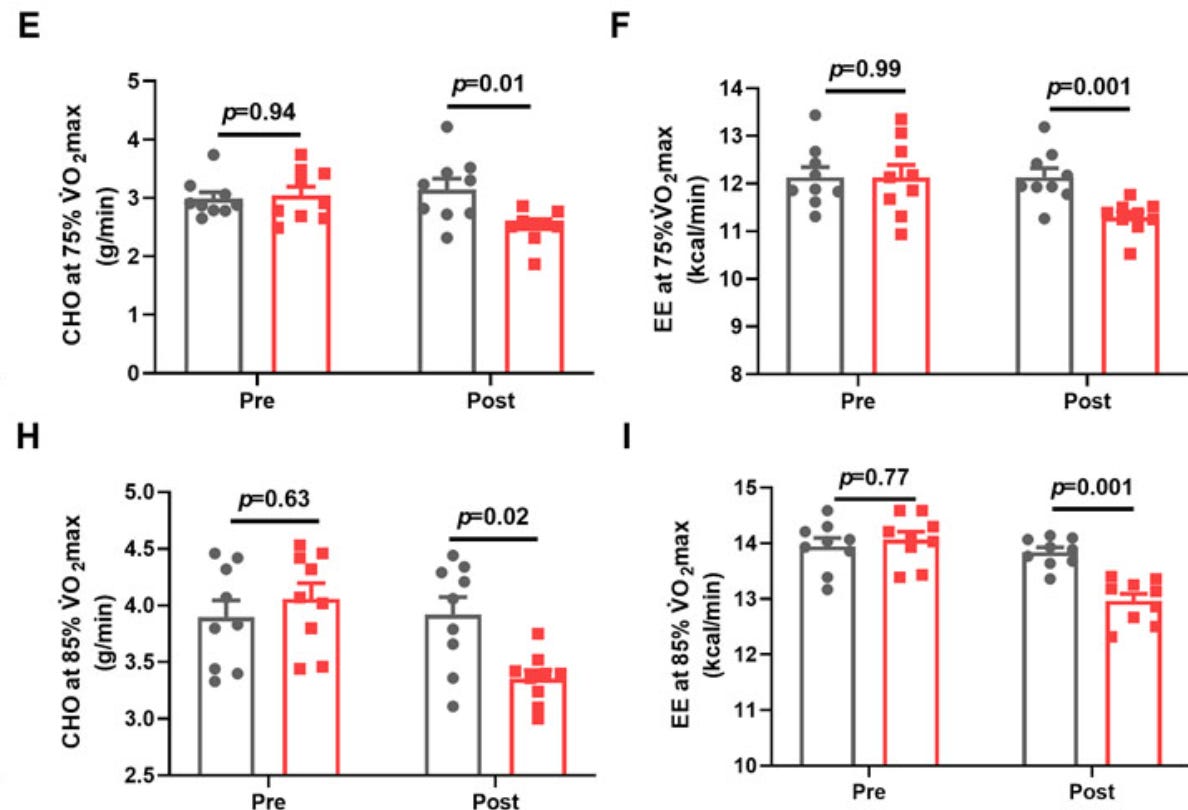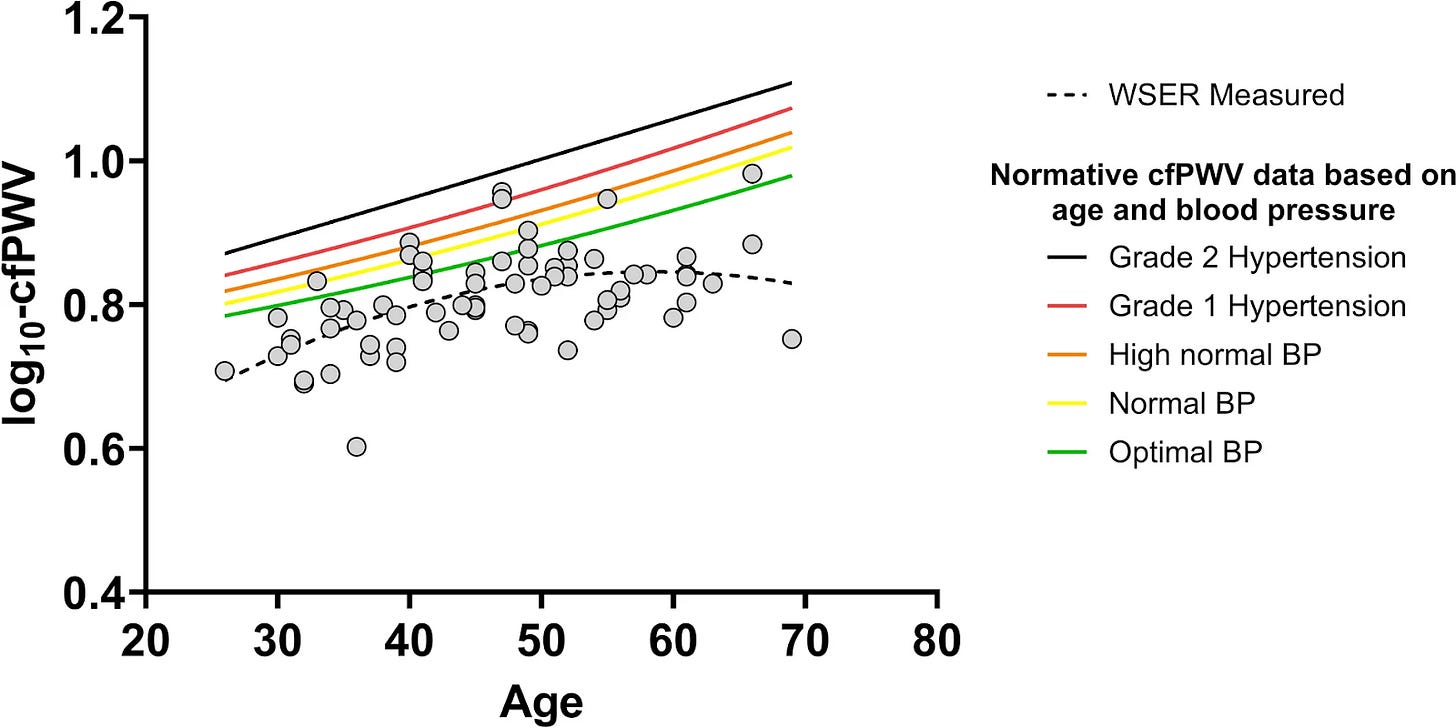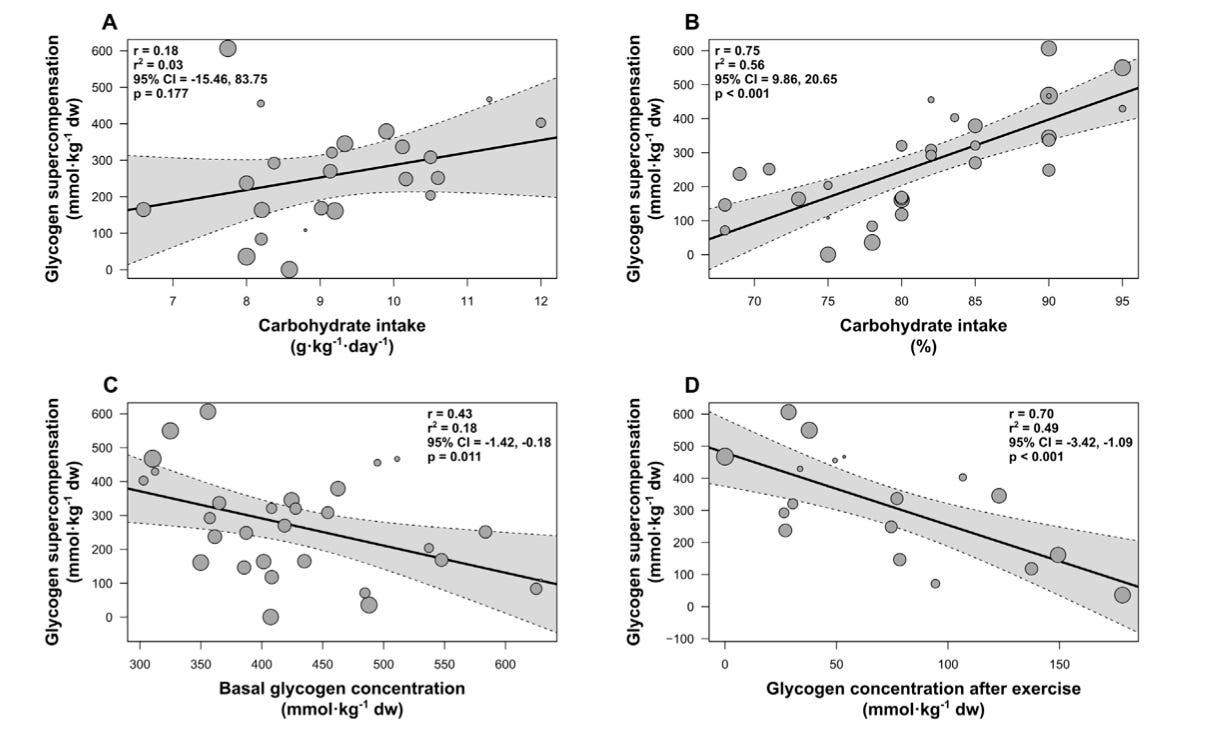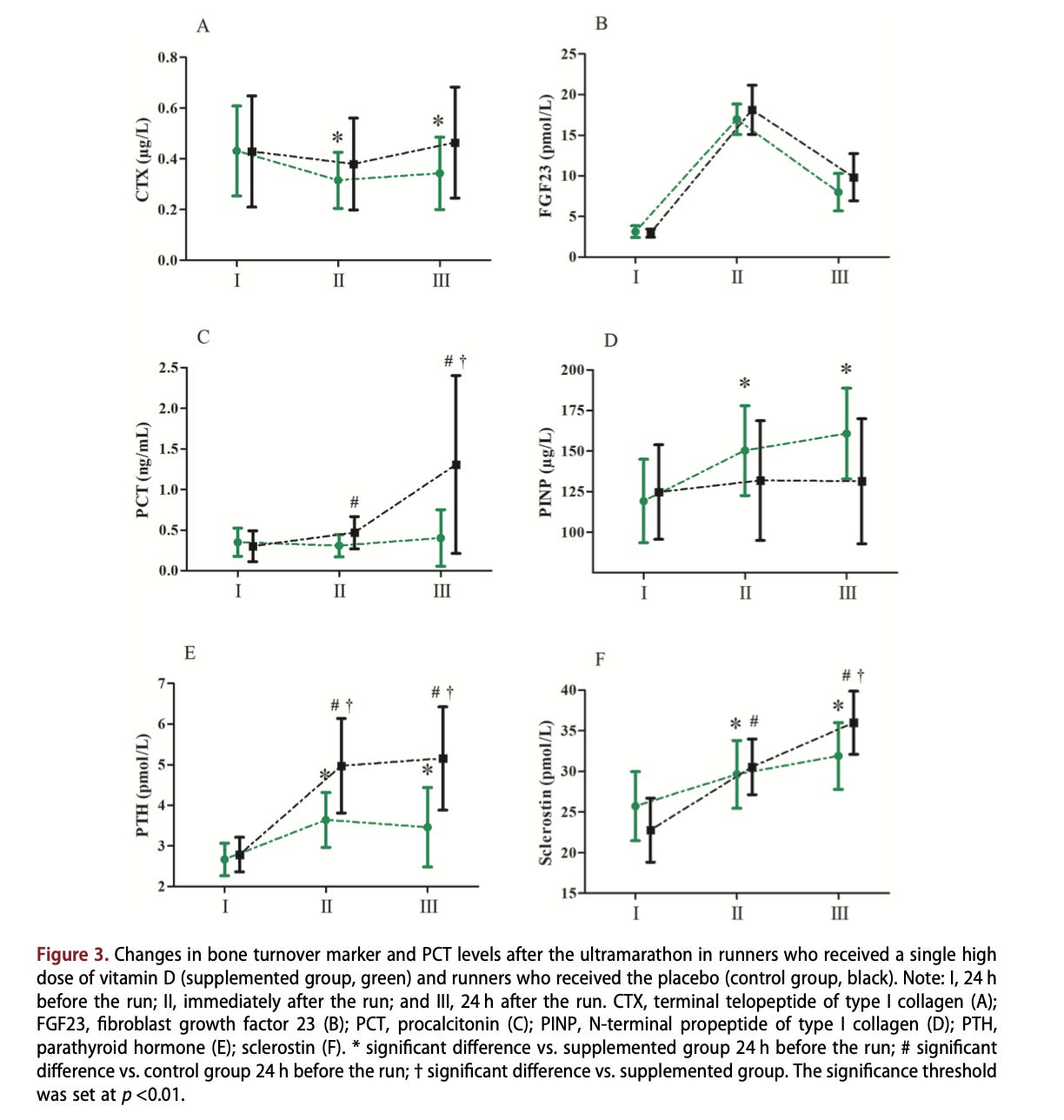Physiology Friday #287: My 5 Favorite Running-Related Studies This Month
Heat and fuel utilization; ultra-running and heart health; carb loading; vitamin D; and testing how long supershoes’ benefits last.
Greetings!
Welcome to the Physiology Friday newsletter.
This week, I’m sharing some short summaries of my favorite running-related studies that I read this month. Even if you’re not a runner, I think you’ll find some useful applications for athletic performance, health, and longevity in them! Here is what’s on tap:
Heat Training Changes How You Burn Fuel
Does Ultrarunning Protect Your Heart or Stress It?
Do Super Shoes Still Work After 90 Minutes?
Does Carb Loading Work?
Vitamin D Before an Ultramarathon Protects Runners’ Bones
Like this format (or don’t)? Let me know in the comments, and I’ll continue to do a once-monthly research wrap-up like this! Enjoy.
Details about the sponsors of this newsletter, including Ketone-IQ, Create creatine, and my book “VO2 Max Essentials,” can be found at the end of the post. You can find more products I’m affiliated with on my website.
Heat Training Changes How You Burn Fuel
Training in the brutal summer heat makes your body feel like it’s working double time (I’m nearly over this scorching Texas summer we’re having). But here’s the fascinating part: training in the heat doesn’t just make you more comfortable in hot conditions—it actually changes how your muscles use energy.
A new study shows that a month of structured heat acclimation can shift your metabolism in ways that might help you race stronger when it’s hot, and probably in cooler temps too.
Eighteen trained male middle- and long-distance runners were split into two groups. One trained in normal temperatures (20–25°C or 68–77℉), while the other did 20 sessions of heat acclimation over four weeks, running in conditions that pushed their core temperature to 39–40°C (102–104℉) each session. Before and after the training block, both groups completed treadmill tests and metabolic assessments in the heat (~30–32°C or 86–89℉).
The heat-acclimated group made several notable adaptations compared to controls. For one, their core temperature during the treadmill test was lower, dropping by ~0.4°C, a clear sign of improved thermoregulation. They also had better aerobic efficiency—oxygen uptake at the first and second ventilatory thresholds increased by ~4% and ~3.7%, respectively. Plasma volume (+4%), hemoglobin (+2%), and erythropoietin (+13%) all rose after heat acclimation, supporting better oxygen transport. This is a classic sign of heat adaptation.
Metabolism also changed in a few ways, and here’s where things get interesting. At submaximal intensities (75% and 85% VO2 max), carbohydrate oxidation dropped by 15–19% in the heat-acclimated group. They relied less on blood glucose and muscle glycogen. After the treadmill test, the heat-trained runners also cleared lactate more efficiently, suggesting improved recovery.
Despite these shifts, overall VO2 max didn’t change. These were efficiency gains, not ceiling-raising ones.
Practical applications
A dedicated block of heat acclimation (about four weeks, five days per week) may give you a metabolic edge. By lowering carbohydrate use at higher intensities, you spare glycogen and delay fatigue, while the thermoregulatory and blood adaptations help you stay cooler and deliver oxygen more effectively. This study is a friendly reminder that all of the blood, sweat (and lots of it), and tears of summer training will bear fruit come the cooler fall racing season.

Do Super Shoes Still Work After 90 Minutes?
We know advanced footwear technologies (aka super shoes) can improve running economy and boost performance. But what happens when the miles pile up? Do the benefits fade as fatigue sets in?
That’s exactly what a new lab study set out to answer. Researchers put nine highly trained distance runners (five women) on a treadmill for 90 minutes to see how running economy and biomechanics changed over time, comparing super shoes to traditional racing flats.
Each runner completed two lab sessions 14 days apart. Both sessions included a submaximal treadmill threshold test and a continuous 90-minute treadmill run. In one condition, participants wore a super shoe, and in another, they wore a traditional racing flat. Side note—the runners were experienced, fast, and fit, with an average age of 32 and World Athletics scores averaging 930 points (equivalent to ~30:17 10K for men and ~36:09 for women).
The researchers used the energetic cost of transport (ECOT) as their primary measure of running economy, alongside biomechanical metrics like step rate, ground contact time, and flight time.
Running economy was 3.2% better in super shoes across the entire 90 minutes—consistent with prior short-duration studies. Over time, economy worsened in both shoes (by ~5.6%), but the rate of deterioration was the same, meaning the AFTs didn’t lose their edge as fatigue set in. Early on, biomechanical differences favored the super shoes, with runners having a lower step rate, a longer flight time, and a shorter ground contact time. But these differences faded over time, suggesting runners’ form adaptations evened out with fatigue, even when wearing the super shoes.
Practical applications
If you’re racing a half marathon, marathon, or longer, your super shoes still deliver late into the run. Their benefit in improving running economy holds steady, even as fatigue creeps in. The 3% running economy improvement from super shoes is consistent and not just a boost you get on fresh legs, although I am surprised that there wasn’t an edge for economy near the end of the run in super shoes compared to the traditional racing flats. Perhaps this requires a bit longer than 90 minutes to manifest. I’m still taking them over a traditional racing flat for the marathon distance.
Does Ultrarunning Protect Your Heart or Stress It?
We’ve all heard the whispers that “running too much isn’t good for your heart.” And with the rise of ultramarathons, that whisper’s turned into a full-on debate. Could all those 20+ mile weekends actually lead to stiffer arteries or elevated blood pressure over time, rather than improve cardiovascular health as endurance exercise is well known to do?
A new field study tackled that question at one of the world’s most iconic endurance events: the Western States Endurance Run (WSER). Researchers tested 71 runners (16 women, 55 men, average age 46) in the final days before the 100-mile race, measuring central and brachial blood pressure as well as carotid-femoral pulse wave velocity (cfPWV)—the gold standard for assessing arterial stiffness.
Despite logging serious mileage (some runners trained up to 40 hours per week), this group’s cardiovascular health looked surprisingly solid. Central systolic blood pressure averaged 116 mmHg, while brachial systolic blood pressure came in at 129 mmHg. cfPWV averaged 6.5 m/s—with 86% of runners having values better than age-predicted norms, indicating more elastic arteries than typical peers. The increase in blood pressure with age was modest. Systolic blood pressure rose just 1.4 mmHg per decade, which is much less than in the general population. However, age did correlate with central blood pressure and arterial stiffness, but the curve was shallow, suggesting years of endurance training may buffer age-related vascular stiffening.
Interestingly, training volume didn’t predict arterial stiffness or blood pressure. Neither total weekly mileage nor hours per week correlated with cfPWV or systolic blood pressure. And while 47% of runners were classified as stage 1 hypertensive based on brachial readings, the researchers caution that this may reflect non-clinical testing conditions—supine posture, altitude (~1900 m), and pre-race excitement (classic “white coat hypertension”).
Practical applications
For endurance athletes, especially those venturing into ultra territory, this study offers both reassurance and nuance. Running long doesn’t seem to accelerate cardiovascular aging. In fact, it may slow it. These ultrarunners had better-than-average arterial stiffness despite high training loads.
So, should you worry about your arteries if you’re running ultras? Probably not. But it’s worth checking in on your heart health with the right metrics—and in the right context—now and again.
Does Carb Loading Work?
Few topics in endurance sports spark as much debate as carbohydrate loading. Ever since landmark studies in the 1960s showed that exhaustive exercise followed by a few days of high-carb eating could double muscle glycogen, athletes have treated “carb loading” like gospel before marathons. But the science has been a bit patchy: some studies confirm massive glycogen boosts while others show little change, and the differences between running and cycling protocols have muddied the waters.
A new systematic review and meta-analysis of 30 studies and 319 participants pulls together decades of research to finally answer the question: how much glycogen supercompensation really happens, and what factors influence it?
To be included, each study had to involve an exercise session that depleted glycogen, a subsequent 3–5 day high-carbohydrate diet, and direct measurements of glycogen.
The analysis separated cycling and running studies, recognizing that these sports stress muscles differently and may deplete glycogen to different degrees. The study also examined what variables (diet composition, baseline glycogen, VO₂max, etc.) predicted the degree of supercompensation.
On average, glycogen increased by ~270 mmol·kg⁻¹ dry weight (dw; this is a standard measure of the glycogen content in muscle) after cycling, versus ~157 mmol·kg⁻¹ after running. In practical terms, that’s a much bigger “fuel tank” boost for cyclists.
The higher the percentage of carbs in the diet, the greater the glycogen gain (no surprise there). Intakes above 8 g/kg/day were consistently effective. Absolute carb grams per day mattered less—once intake was “sufficient,” more didn’t add much. Lower baseline glycogen and lower post-exercise glycogen were both linked with larger supercompensation. In other words, the more you deplete, the more room there is to store during the “reload” phase.
Even with extreme loading, no study exceeded ~1,000 mmol·kg⁻¹ dw. Most athletes topped out around 700 mmol·kg⁻¹ dw, suggesting a ceiling on storage capacity. Men showed ~294 mmol·kg⁻¹ increases while women increased their stores by ~152 mmol·kg⁻¹, a finding that likely reflects lower energy intake in female participants in older studies, not a true physiological gap.
An interesting finding for running was also observed. Several running studies showed blunted or absent supercompensation. The authors suggest muscle damage from eccentric contractions may impair glycogen resynthesis.
Practical applications
If you’re looking to carb load properly, maximize carb percentage in your diet, not just grams. A diet that’s 70–90% carbs for 2–3 days seems key. And make sure to go into your carb load depleted, because the biggest glycogen gains happen when you start low, so a glycogen-depleting workout paired with a slightly lower carbohydrate intake for a few days before loading may help. It’s not just about “eating more carbs,” but doing so strategically. Finally, it may be wise to avoid hard downhill running that could cause intense muscle damage, as this appears to reduce the effectiveness of carb loading to some degree.
Vitamin D Before an Ultramarathon Protects Runners’ Bones
Carbs and hydration (and maybe some caffeine) are typically front and center of any ultramarathon fueling strategy, but rarely do we think about bone health. Yet ultrarunning doesn’t just tax muscles and the cardiovascular system. The mechanical stress, long hours on the trails, and eccentric downhill pounding can disrupt bone metabolism and increase markers of bone breakdown. Maybe not incredibly concerning in the short term, but it does raise an interesting question: could something as simple as vitamin D supplementation protect our bones during extreme endurance events?
That’s what a new study set out to test.
Researchers recruited 40 semi-professional male ultramarathoners competing in a 240-kilometer mountain race in Poland. The runners were randomly assigned to receive either a massive single dose of vitamin D3 (150,000 IU dissolved in oil) or a placebo, taken 24 hours before the start.
Blood samples were collected at three points: 24 hours before the race, immediately after, and 24 hours post-race to measure things like vitamin D levels, markers of bone health, hormones, and proteins linked to inflammation.
Not surprisingly, vitamin D levels skyrocketed in the supplemented group—serum vitamin D jumped by ~147% after the race compared with ~85% in the placebo group. CTX, a marker of bone breakdown, dropped in the vitamin D group immediately and 24 hours post-race, while the placebo group didn’t show meaningful changes. Sclerostin, a molecule that inhibits bone formation, also rose in both groups but was significantly higher in placebo runners. PINP, a marker of bone formation, rose significantly only in the supplemented runners.
All of this suggests that the single high dose of vitamin D helped tip the balance toward bone building.
Parathyroid hormone or PTH (which rises when calcium levels dip, driving bone resorption) increased less in the vitamin D group, and the pro-inflammatory procalcitonin spiked in the placebo runners but was curbed with vitamin D supplementation.
Practical applications
Even though the study included only men who were all relatively seasoned runners, the findings suggest that vitamin D might act like a “bone shield” during extreme endurance events, reducing bone resorption and inflammation while promoting bone formation. One big pre-race dose worked here, but in practice, maintaining healthy vitamin D levels year-round through sunlight, diet, or supplementation is the more reliable strategy. Low vitamin D levels may leave you more vulnerable to bone stress and breakdown during heavy training or racing, so be sure to monitor levels somewhat regularly!
The VO2 Max Essentials eBook is your comprehensive guide to aerobic fitness, how to improve it, and its importance for health, performance, and longevity. Get your copy today and use code SUBSTACK20 at checkout for a 20% discount. You can also grab the Kindle eBook, paperback, or hardcover version on Amazon.
Ketone-IQ is high-performance energy in a bottle. I use it for post-exercise recovery along with enhancing focus, mood, and cognition. Take 30% off your order.
Create is the first “modern creatine” brand. They sell a wide range of creatine monohydrate gummies—and yeah, their gummies actually contain creatine, unlike some other brands. They’re giving my audience 20% off their order. So stock up!








When would you complete the heat training “block” in relation to a marathon training block? Would you do it 12+ weeks out from the marathon (in the base phase as people call it) or sometime closer to the race itself? I feel like I got some heat adaptations from summer running but don’t want them to go away before my October 12th marathon. Thanks!